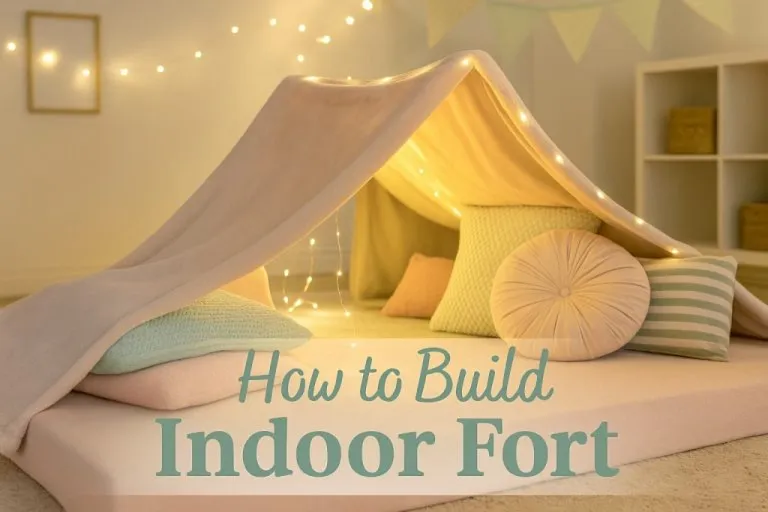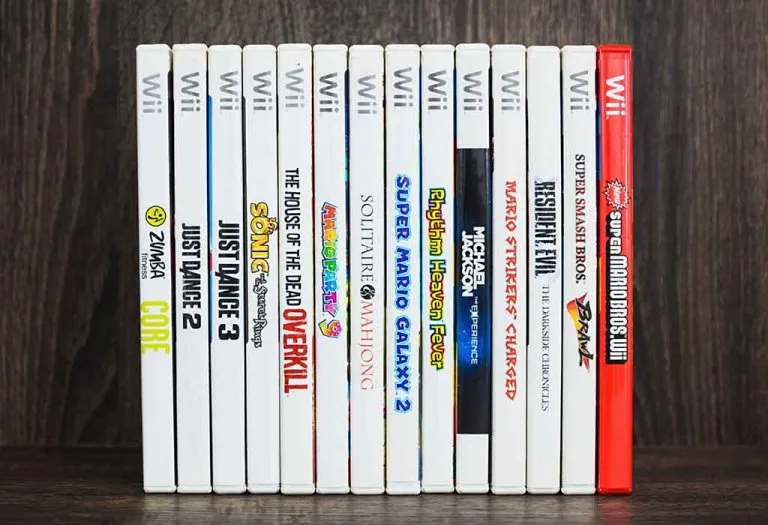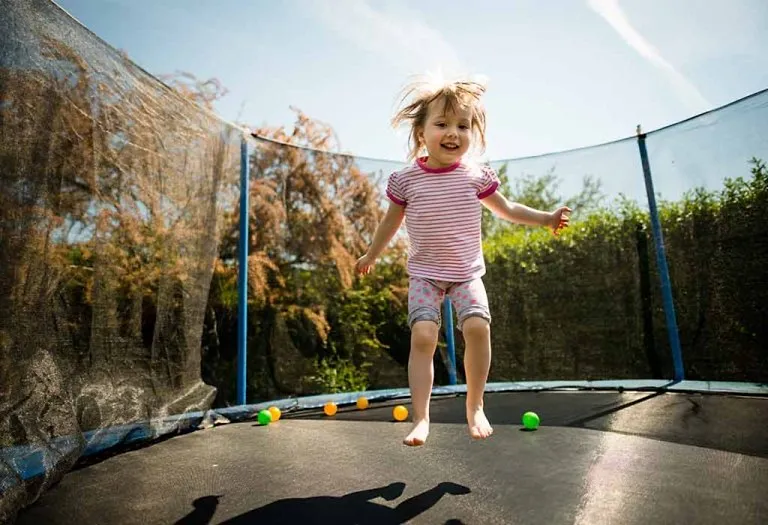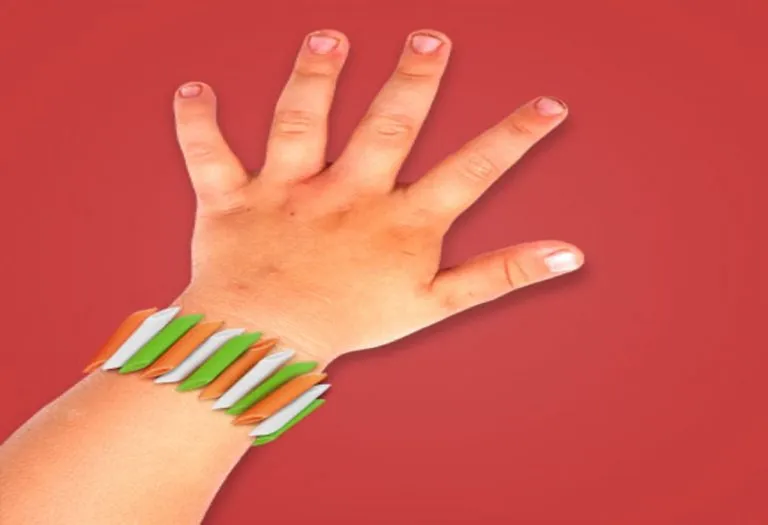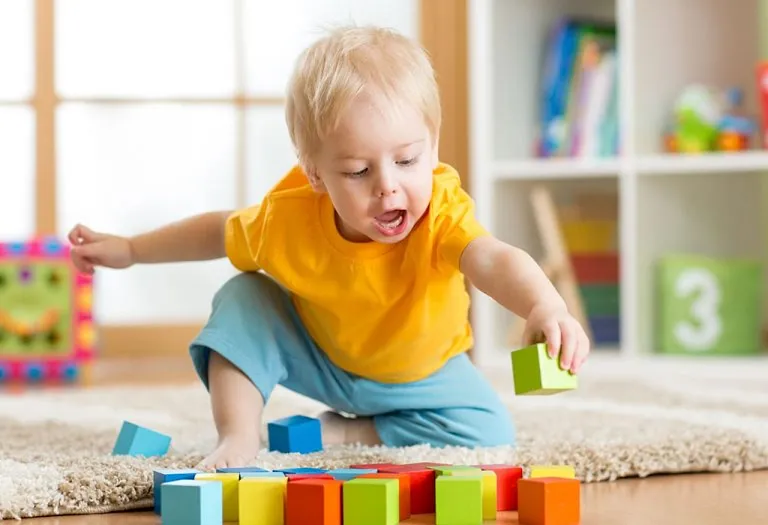How to Build Indoor Forts – Ideas with Blankets, Cardboard & More for Kids
As a parent, it can be challenging to find time to get anything done for yourself. What can you do when you really need just a little time for yourself? Give the child something that can keep him engaged. And a great idea to keep your little one entertained for longer periods is to build a fort! Forts can spark your child’s creativity, provide a personal reading nook, secret hideout, and a tribal home-play space, among other benefits! There is no end to creativity when it comes to this idea, and what your child can use it for. So, without further ado, let’s explore some top indoor fort ideas to give your child the creative space they need.
Creative DIY Indoor Forts for Children
There are numerous ways to create forts for kids. Here are some easy indoor fort ideas you can consider. You can either involve your child in making one or surprise him.
1. Rocket Fort
If your kid is a space buff, this Rocket Fort is the one to go for. It is affordable as you’d be using recyclables and very easy to make.
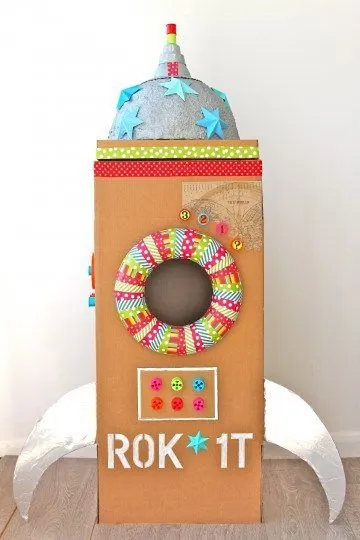
Image Credit: Pinterest
Supplies:
- A large rectangular cardboard box
- A smaller rectangular box in the shape of a pizza box
- Two cardboard strips
- Hanging basket liner
- Different-sized yoghurt pots, from wide to narrow
- Polystyrene wreath ring
- 12 cotton reels
- 2 old plastic lids
- 3 bottle caps
- Paper stars to decorate the rocket dome
- Decorative paper
- Chalk
- Foil
- Glue
Instructions:
- Take the large cardboard box, and on one side, cut out a circle for the window. You can use the polystyrene ring to trace out the circle.
- Choose a side of the cardboard box where you want the door. On that side, draw a vertical line and two horizontal lines starting from each end of the vertical line (like a ‘c’ without curves). Cut along these three lines. The door should now swing open and shut.
- Next, glue the pizza box cardboard onto the top of the rocket.
- Then you will need to glue the hanging basket liner upside down to form a dome.
- Then, you will need to glue the yoghurt pots, starting with the biggest to the smallest, so that they look like the pointed nose of a rocket ship.
- You can cover everything with foil or decorative paper.
- Once you are done with the top of the rocket, you can start on the sides.
- Take your polystyrene ring and decorate it using decorative paper.
- Stick this ring around the circle cut-out on the large cardboard box. Use a strong glue if you have to. Ensure you do this step if it isn’t safe for your kid to do it.
- Take four of the cotton reels and glue them near the polystyrene ring.
- With your decorative paper and marker, you can write down numbers to make the launch countdown.
- Underneath, you can make a control panel using some more cotton reels.
- You can take the plastic lids and turn them into some more control panels on another side of the cardboard box.
- Make doorknobs for the door and some paper or cotton reels. You should put a doorknob on the inside as well so that your little astronaut can shut the door properly.
- On the door, you can make a little plaque that says “Captain”.
- With your two strips of cardboard, you can cut out the side wings of the rocket. These can be covered in foil.
- You can get as creative as you like when making a rocket for your child.
2. Under-the-Table Fort
This is one of the most common and easiest forts you can make for your little one. Almost everyone has had an under-the-table fort at some point, and it has been the location of many beautiful memories. Each person’s fort will be different, depending on the type of table that you have at home.

Image Credit: Pinterest
Supplies:
- A dining table or any other tall table
- A king-sized sheet
- Cosy rugs
- Pillows
- Blankets
- Props
Instructions:
- All you need to do for this simple fort is drape your king-sized sheet over the table to create the “walls” of the fort.
- If you have some cosy rugs to use on the floor of the fort, then spread them out, too.
- Place some pillows around the fort and some blankets as well to make it comfortable and inviting.
- Now, add in the props depending on what your child wants to use the fort for.
- If your child wants to use the fort as a reading nook, add a pile of books that your child loves to read, along with a reading light.
- For kids who want to use it to play “house”, you can section the fort into two, make the cosy blanket side the place for sleeping, and the other side can be filled with play kitchen items.
3. Teepee Fort
This teepee fort will take some more effort to make than the other types of forts, but it is worth it. Add some fairy lights to make it seem more magical and cosier, and you will probably have trouble getting the kids out.
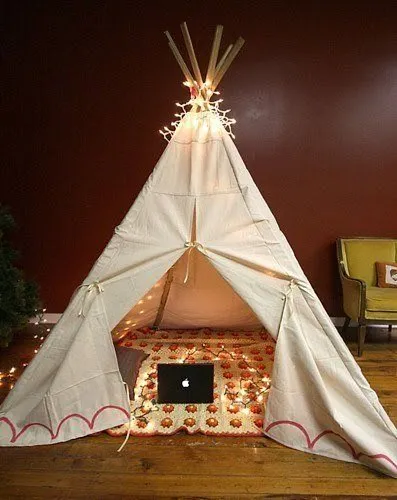
Image Credit: Pinterest
Supplies:
- 1″ x 2″ x 8′ Wooden Dowels, 6
- Drop cloth, canvas, 9’x12′
- Acrylic paint, 1 tube
- Paintbrush, 1
- Satin ribbon, cream coloured, 3/4″ width, 2 rolls
- Elastic, 1/4″, 15
- Drill
- Yarn
- Yardstick
- Leather cord
Instructions
- Tie the tops of the dowels loosely with some yarn so that you can shift them around.
- Decide on how wide you want the teepee.
- Once you decide, you can tighten the yarn to keep enough distance between each of the wooden dowels.
- Measure the distance between each leg.
- Measure the distance between the bottom of the poles, at the middle and then at the top.
- With the help of a yardstick, hold the canvas taut from the top all the way down to the bottom so that you can trace out the lines neatly according to the measurements you took.
- Then, cut out the panel. Use this one as the stencil for the rest of the panels.
- The panel that you are using as the front panel will need to be cut in the middle, starting from the bottom and moving to the top. Make sure that you do not cut it all the way through. You will need the top to remain intact so that the front panel doesn’t split into two.
- Hem the middle of the panel, so it looks neat.
- You can either have the entrance panel pinned back so that the inside is always visible, or you can allow it to fall together, remaining “closed”.
- Once you have cut out all your panels, you will need to start sewing the panels together. As you are sewing the sides together, make sure that the tops are all even.
- Fold 1/2″ of the top edge and sew it to make a hollow loop for an elastic.
- String the elastic through it. You can use a safety pin to string the elastic. Stitch the ends of the elastic.
- Once you have made the top, you can finish sewing up all the sides of the teepee.
- Then, fold the bottom 1/2″ at least twice.
- Take three ribbons of 12″ and stitch them on the inner seams of each of the panels. You will need to tie them around each of the dowels to keep the panels in place.
- You can decorate your tent as you like to make it even more interesting.
4. Hallway-Fort
You can make a lovely little fort house using just a few tension rods. You’ll need walls or vertical surfaces to jam the tension rods into to make it work. This is an interesting fort to make in doorways, hallways, and so many other interesting spots.
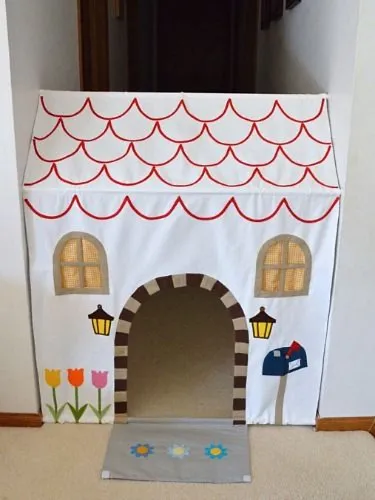
Image Credit: Pinterest
Supplies:
- Tension rods, 3 or more
- Fabric for your house (you will need to decide the measurements based on your tent design)
- Bias tape
- Sewing machine
Instructions:
- Start out with making the roof. Sew channels that will hold the tension rods. You will need to measure the tension rods and add an inch extra to the measurements when you are cutting out the material for the channels.
- Sew the channels on what will be on the inside of the fort.
- If you want just the flat roof, you will need to make only two of these channels.
- Using bias tape, sew curves or any tile shape that you want onto the roof panel.
- Use the same technique to cut out the door frame.
- Move on to the windows next. You will need to make the dimensions of the windows on paper and then use an accent fabric of another colour to make the actual window frame.
- Using the paper cut out, trace the window frame onto the accent fabric and then cut it out.
- The template can also be used on the wall fabric to cut the windows out.
- Stitch the window frame on the outside of your wall fabric.
- Now, to make the window curtains, use a different material. Stitch the curtains on the inside of the windows. This will give your child the ability to manipulate them to open and close the curtains according to his wish.
- You can add some more decorations of your choice.
- For the floormat, you can use a different fabric of your choice that fits the size of the bottom of the door.
- On one side of this, you can create a channel for the floor mat to fit through the tension rod.
- Once you are done decorating your walls, you can set this up in any hallway you want.
5. Aladdin-Inspired Fort
If your kids are fans of Aladdin, this fort is going to make them very happy. The fort itself is quite easy to make. The materials are cheap, and it is not as time-consuming as you may think. All you need once the fort is made are some Agrabah-inspired props to seal the deal.
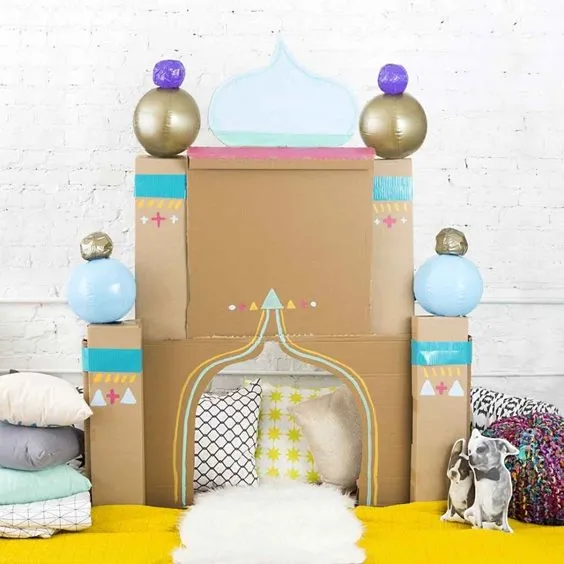
Image Credit: Pinterest
Supplies:
- Cardboard, 2 large, and a couple of smaller ones
- Beach balls, 4 large, 4 small
- Paints
- Spraypaint in gold and blue colours
- Paintbrushes
- Glue gun
- Cardboard cutter
- Marker
- Duct tape
- Props
Instructions:
- With the cardboard cutter, trim your cardboard boxes to make two long rectangular shapes.
- Pick where you want to have the entrance and then trace out the shape of the door.
- With the cardboard cutter, cut out the door.
- With the duct tape, attach the large bases to the ground.
- On each side of the base, secure two rectangular posts.
- You can get creative and use the paint to add your own designs.
- Spraypaint two of the large beach balls in gold, and two in blue.
- Spraypaint the smaller balls in the same way.
- Stick the beach balls onto the fort, matching one blue ball with one gold ball.
- Add in your blankets, rugs and pillows.
6. Newspaper Fort
This project is not only fun for the kids to join in on, but it is also a great way to recycle some of the newspaper that you have piling up. There is no hard and fast rule on the shape of this fort, so you and the kids can get creative here. Make whatever shape you like, as long as you make sure the structure is sturdy. Use a lightweight sheet as the tent covering.
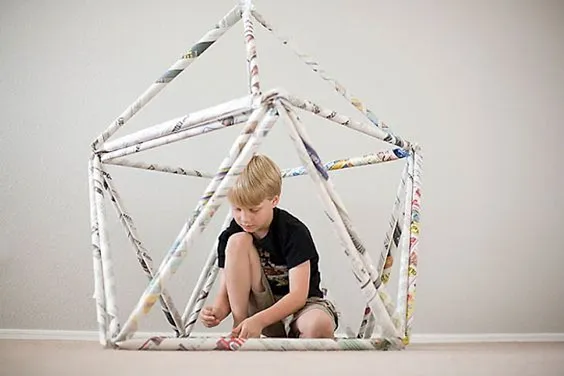
Image Credit: Pinterest
Supplies:
- Newspaper
- Tape
- King-sized sheet
- Pillows
- Blankets
Instructions:
- Lay two sheets of paper flat on the floor.
- Pick up one of the corners and then start rolling it into a tight roll.
- Tape the end so that the roll doesn’t unravel.
- Roll at least 48 tight rolls.
- With these rolls, make triangles. You will need to tape the corners together.
- Keep making the triangles until you run out of the rolls.
- Now is when you get really creative! Secure each of the triangles together, coming up with your own unique structure.
- Ensure that you have secured the joints securely using extra tape. This way, things won’t shift around.
- Lastly, cover the structure with a sheet and fill the inside with cosy blankets and pillows.
7. Simple Fort With Lights
Making a fort doesn’t always need to be complicated. Sometimes the simple route is the best one. A cosy fort with some comforting lights is just what you need. This is a great choice of indoor forts for toddlers as it is quite safe and has a cosy appeal. Older kids will love it too.
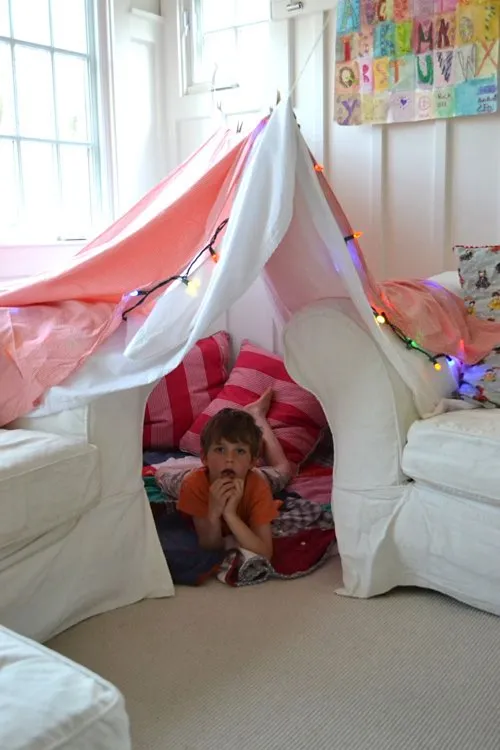
Image Credit: Pinterest
Supplies:
- Lights
- Strings
- Clothespins
- Sheets
- Nail
- Hammer
- Pillows
- Blankets
Instructions:
- For this fort, you will need to put a string on two secure points, running from one wall to another.
- Use the nails and hammer to make the secure points for you to hang the string from if you don’t already have anywhere to secure it in place.
- To make the fort cosier, you should select a place to set up the fort in a comfortable corner. You can even have it set up in the corner of the living room between two couches.
- Hang the sheet over the string to resemble a tent.
- You can set this up by adding stringed lights around the entrance to the fort.
- Organise the blankets and pillows to make the inside of the fort cosy, and you are all done!
8. Cosy-Up Fort
If you are able to make this fort large enough, you can get in and cuddle with your little one while enjoying a movie. It is the perfect fort for a cold winter’s night, and it is really easy to put together. Add in some snacks and a warm beverage, and neither of you will want to leave the fort.
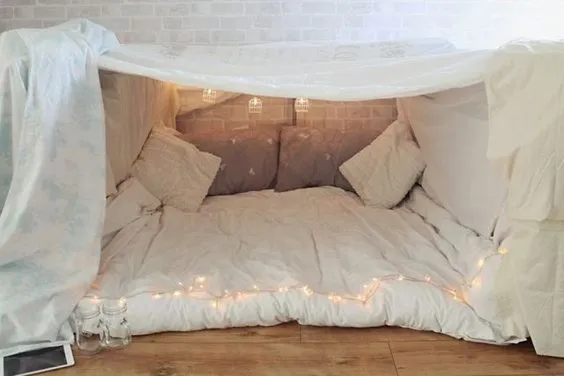
Image Credit: Pinterest
Supplies:
- A thick blanket or mattress
- Sheets to drape
- Pillows
- Fairy lights
- Sofas or chairs to drape the sheets over
Instructions:
- Place chairs or sofas backwards on either side of your blanket or mattress.
- Drape the sheets over everything to create a cosy nook-like space.
- Add some fairy lights and pillows for a cosy atmosphere.
- Grab your laptop and snacks, and you can all get in for a very cosy movie time.
9. Reading Fort
If your child loves reading, this could be a great addition to the room. Having a fort already makes you feel like you are in another world, so paired with a book, it is going to allow your child’s imagination to soar!
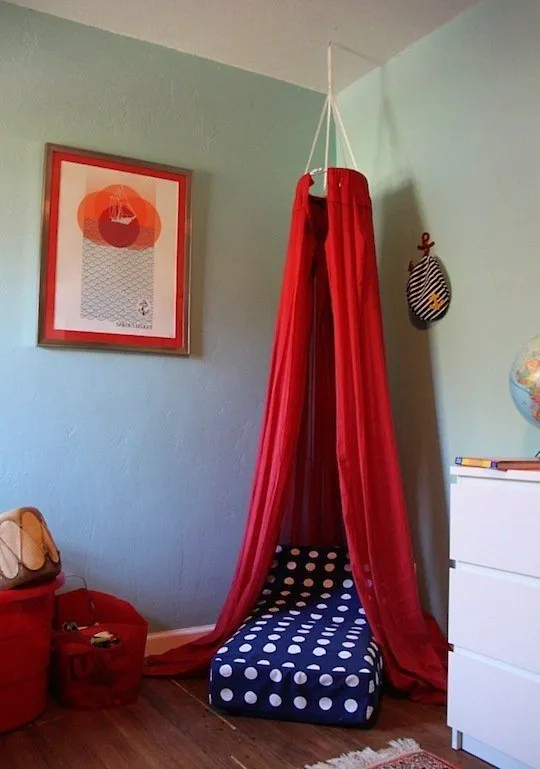
Image Credit: Pinterest
Supplies:
- Ceiling hook
- Embroidery hoop, 12″ in diameter
- Curtains, 4
- Mattress/Lounger
- Ribbons
Instructions:
- Slip the embroidery hoop through the channels in the top of the curtains.
- Attach some ribbons from the ceiling hook and secure the embroidery hoop to it.
- Place your child’s lounger or mattress under the tent, and you have a cosy little reading nook.
- If you are using a mattress instead of a lounger, add some pillows so your child can recline while reading.
10. Bunk Bed Fort
If you have a child who loves turning his bottom bunk into a fort, this is something you should think about adding to your child’s bed. With this slightly more permanent fixture, your child can just slide the fort curtains to open and shut it. The fixtures are also easy to remove when you want to wash them or change them to another colour.
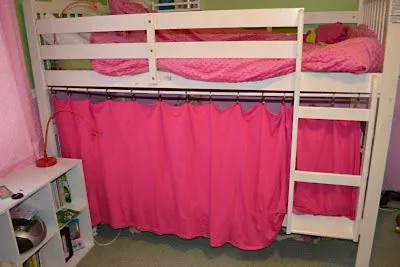
Image Credit: Pinterest
Supplies:
- Twin sheet
- Curtain rings that have clips
- Tension rod
Instructions:
- Slip the curtain rings onto the rod.
- Fix the tension rod onto the bunk bed.
- Fold the sheet lengthwise in half.
- Attach it to the curtain ring clips.
11. Cardboard Fort
This cutesy cardboard fort is simple and easy to make. You can make use of the cardboard lying around the house and other items for decorating the fort, and teach your children about the concept of recycling.
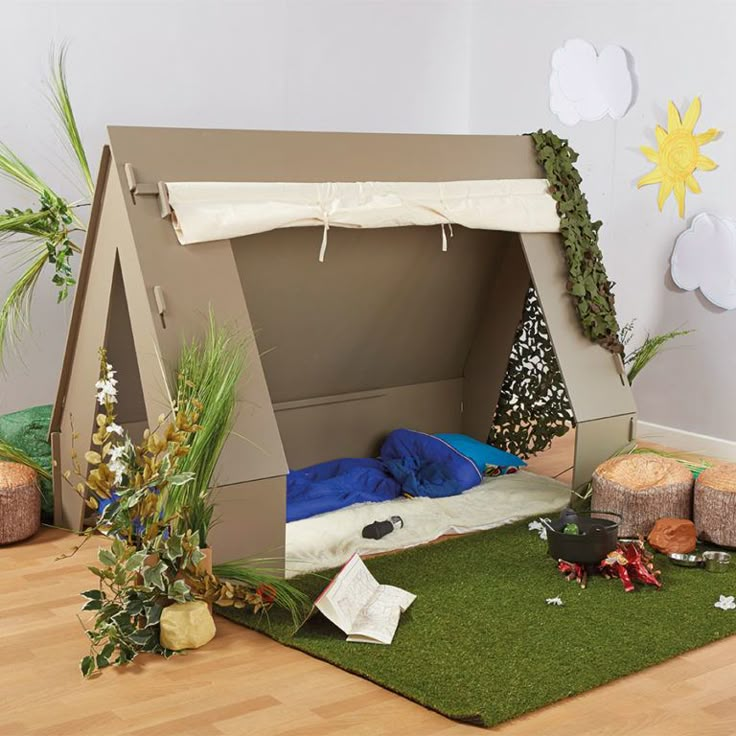
Image Credit: Pinterest
Supplies:
- Big cardboard sheets
- Scissors
- Tape or string
- Bedsheet/quilt/sleeping bag
- Cushions
- Stapler
Instructions:
- Take two large cardboard sheets or panels and lean them together to form a triangle shape (like a tent). Then, secure the top with tape or a string to prevent it from slipping.
- Use extra cardboard sheets for the sides and back, securing them with tape. Leave the front open for the entrance.
- Attach a fabric sheet or canvas across the top edge of the front. Tie or roll it up so kids can open and close it like a real tent flap.
- Now, decorate the inside and outside of the tent with cushions, a sleeping bag, a bed sheet, or a quilt.
- Add in your kiddo’s toys and storybooks.
12. Paper Roll Fort
Another craft plus decoration idea for indoors is a paper roll fort. You can make use of the leftover cardboard/paper rolls and build a cutesy fort for children indoors. This one also hints at the concept of recycling.
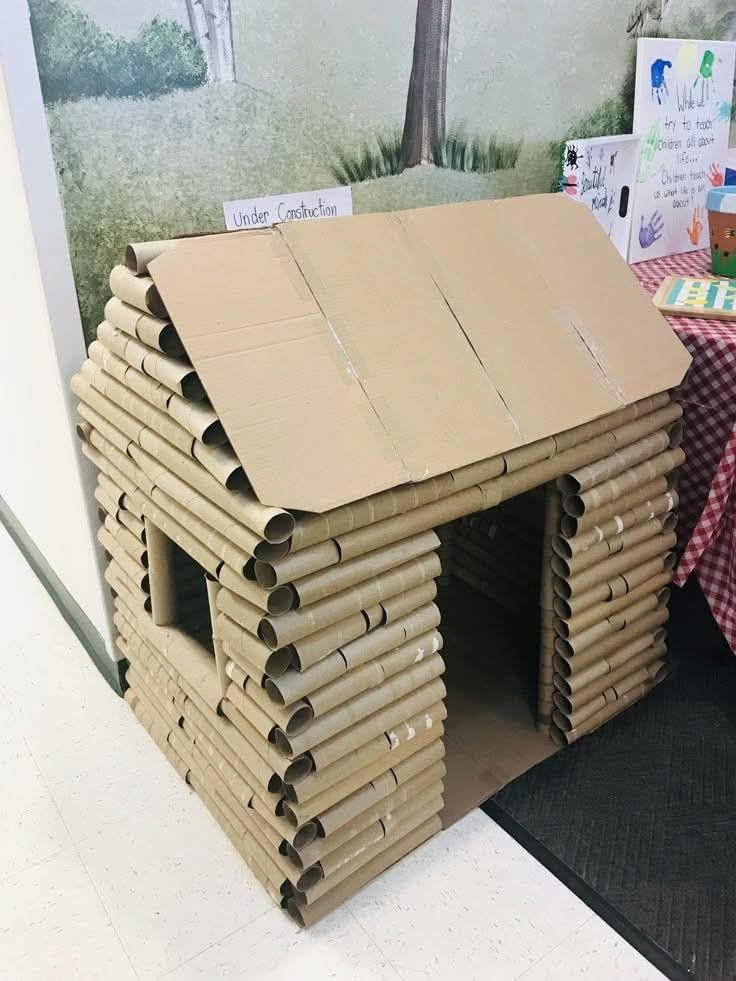
Image Credit: Pinterest
Supplies:
- Large cardboard sheets
- Box cutter or scissors
- Strong tape
- Ruler and pencil
- Hot glue gun
Instructions:
- Measure and cut out several triangles of equal sides/lengths.
- Make about 30-35 triangles.
- Start by taping five triangles together in a circular shape to create the top of the dome.
- Continue attaching triangles around the top piece, layer by layer.
- Keep taping edges firmly so the dome holds its shape.
- When you reach the lower level, leave one gap as the doorway.
- Add extra tape or glue along the inside seams for stability.
13. Eskimo Fort
Something new and unique, Eskimo fort hits different. If your little one is curious about new things, then through this Eskimo fort, you can teach your kiddo about the geography where Eskimos are found and how they are made.
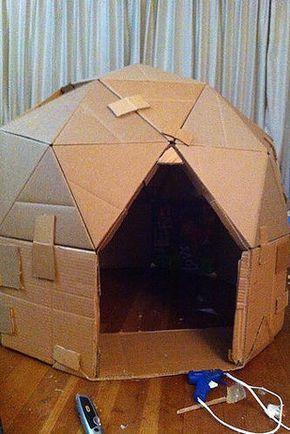
Image Credit: Pinterest
Supplies:
- Cardboard tubes (from wrapping paper or mailing tubes)
- Flat cardboard sheets (for roof, base, and support)
- Strong tape or hot glue
- Box cutter or scissors
Instructions:
- Cut cardboard tubes to the same length.
- If you don’t have tubes, you can roll strips of cardboard tightly to create cardboard tubes.
- Lay two “logs” parallel on the floor, then place two more across them (like a log cabin corner).
- Continue stacking layer by layer, taping or glueing at the corners.
- Leave open spaces in the stack where you want a window or door.
- Place two flat cardboard sheets on top to form a pitched roof.
- Tape them together along the middle seam.
- Add extra tape inside corners so it doesn’t wobble.
14. Colourful Teepee Fort
Make this rocket fort with your kiddo and help them begin their journey of space exploration!
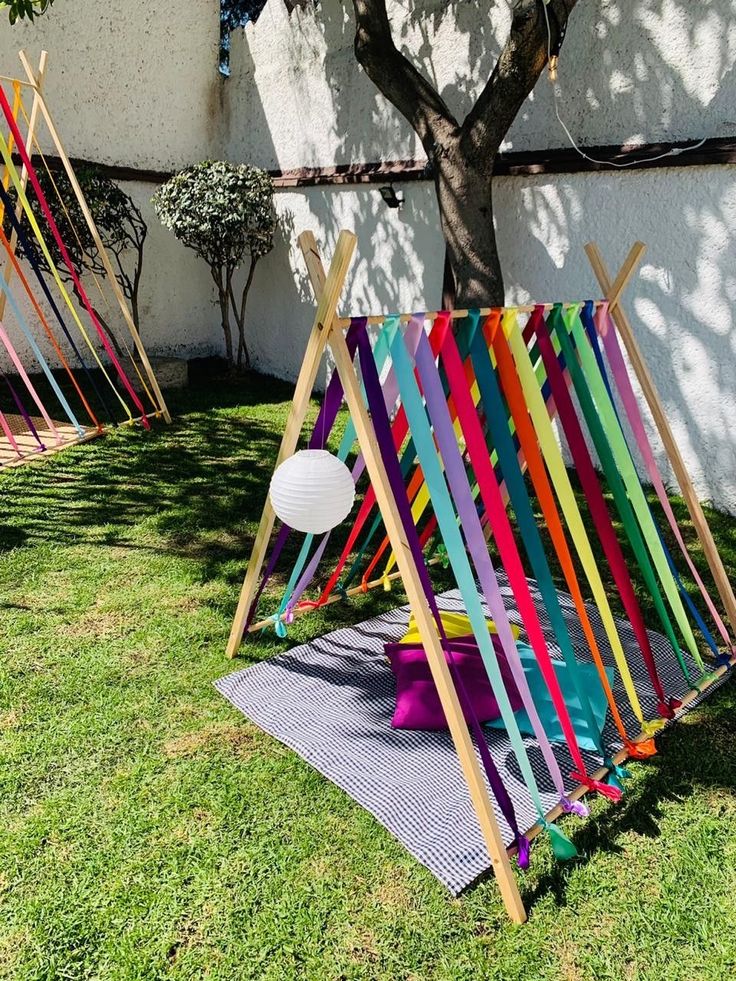
Image Credit: Pinterest
Supplies:
- 4 wooden dowels
- 3 wooden sticks
- Nails
- Hammer
- Colourful paper ribbons
- Paper lantern
Instructions:
- Adjoin the top of two wooden dowels in a V-shape. Do the same for the other set.
- Now, join both V-shaped dowels with a wooden stick or dowel on each side.
- Your structure for fort is ready. Now tie colourful paper ribbons from one end to the other as shown in the picture above.
- Your colourful teepee fort is ready.
15. Fairy Tale Fort
An indoor fort like this creates a magical hideaway for kids as a cosy spot for reading, playing, or simply relaxing. Add soft lights, hang some light stars, and place in comfy cushions, and you’ll step into a storybook world!
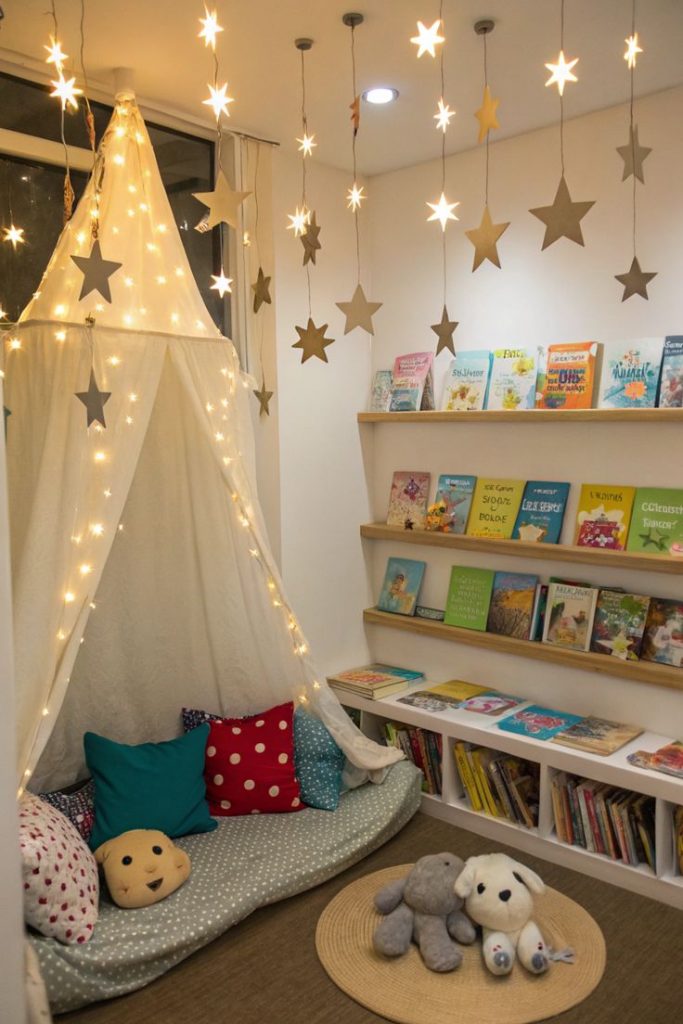
Image Credit: Pinterest
Supplies:
- A hula hoop, embroidery hoop, or lightweight curtain rod
- Long piece of fabric, sheet, or curtain
- Fairy lights or string lights
- Tape, hooks, or ceiling adhesive hooks
- Paper stars or cardboard cutouts
- Cushions and pillows
- A floor mat or soft blanket
Instructions:
- Secure a hook in the ceiling and tie your hula hoop (or embroidery hoop) to it with string.
- Drape the fabric or sheet over the hoop so it falls like a tent.
- Wrap fairy lights around the fabric edges or drape them over the canopy.
- If using battery-operated lights, tuck the battery pack discreetly inside.
- Cut star shapes from cardboard or thick paper.
- Hang them from the ceiling using string or tape them around the canopy for a dreamy night-sky effect.
- Place a mat, soft rug, or folded blanket as the base. Add plenty of cushions and pillows for lounging.
- Add a few stuffed animals and books to create a cosy reading corner.
FAQs
1. What do children learn from building a fort?
Fort building teaches kids planning, problem-solving, and creativity. It also helps them understand basic design concepts, use their imagination, and stay active through hands-on play.
2. What household items can be used to make a fort?
You can use bedsheets, blankets, pillows, chairs, clothespins, and curtain rods to build a fort. To make it even more fun, consider adding LED lights, bunting, or other decorative elements.
3. What are some tips for building a fort with a group of children?
Let every child share their ideas, assign simple tasks, and ensure that materials are safe and sturdy. Keep an eye on them while they build, and encourage teamwork to ensure the process remains fun and cooperative.
4. Do forts built by kids need maintenance?
Indoor forts usually don’t, since they’re temporary. Outdoor forts, however, may need regular checks to fix loose parts, remove sharp objects, and protect them with weatherproof paint and safe furniture.
Regardless of your child’s age, they will love having a fort to spend time in. With so many different choices of the best indoor forts, you are bound to find one that will suit your needs. Children are not difficult to please, so do your best with the fort, and they will love it! Your child will make many pleasant memories in the fort, whether he chooses to play in it alone, with siblings or with his friends.
Also Read:
Homemade Toys for Children
DIY Dollhouse Ideas for Kids
DIY Mask Making Ideas for Children
Plaster of Paris Crafts for Kids
Was This Article Helpful?
Parenting is a huge responsibility, for you as a caregiver, but also for us as a parenting content platform. We understand that and take our responsibility of creating credible content seriously. FirstCry Parenting articles are written and published only after extensive research using factually sound references to deliver quality content that is accurate, validated by experts, and completely reliable. To understand how we go about creating content that is credible, read our editorial policy here.





